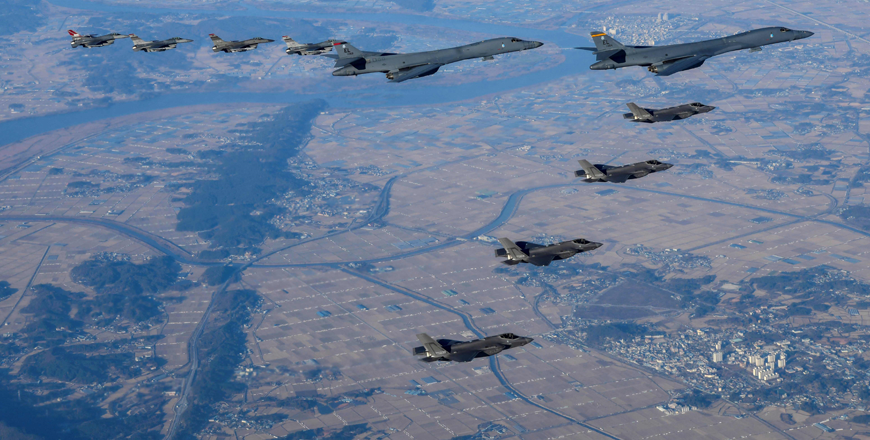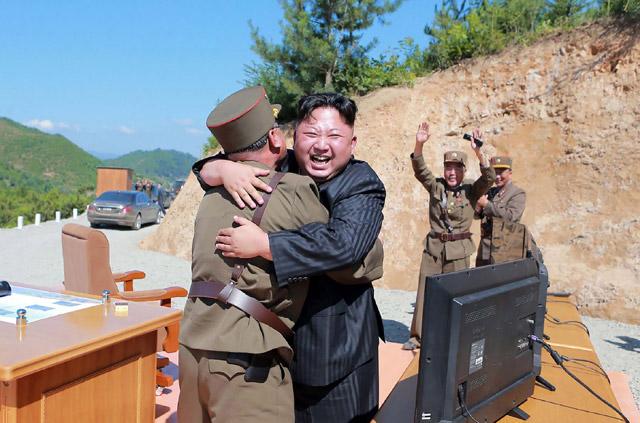You are here
N. Korea launches ballistic missiles as US-S. Korea air drills end
By AFP - Nov 06,2022 - Last updated at Nov 06,2022

This handout photo taken on Saturday and provided by the South Korean Defence Ministry in Seoul shows two US Air Force B-1B heavy bombers (centre), four South Korean Air Force F-35 fighter jets and four US Air Force F-16 fighter jets flying over South Korea during a joint air drill called ‘Vigilant Storm’ (AFP photo)
SEOUL — North Korea fired four ballistic missiles on Saturday, the South Korean military said — the latest in Pyongyang’s testing blitz this week as Washington and Seoul concluded their biggest-ever air force drills.
The flurry of North Korean launches has included an intercontinental ballistic missile and one that landed near the South’s territorial waters. South Korean President Yoon Suk-yeol has called the barrage “effectively a territorial invasion”.
The launches came as hundreds of US and South Korean warplanes — including B-1B heavy bombers — participated in the Vigilant Storm exercise, which Pyongyang described as “aggressive and provocative”.
“The South Korean military detected four short-range ballistic missiles launched by North Korea from Tongrim, North Pyongan Province, to the West Sea at around 11:32am to 11:59am today,” South Korea’s joint chiefs of staff said in a statement Saturday, using another name for the Yellow Sea.
Their “flight distance was detected at about 130km, an altitude of about 20km, and a speed of about Mach 5”, they added. Mach 5 is equivalent to five times the speed of sound.
The United States and South Korea have warned that these launches could culminate in a nuclear test by North Korea, and extended their air force drills in response by a day, until Saturday.
Pyongyang ramped up missile launches in response to the drills. Such exercises have long provoked strong reactions from North Korea, which sees them as rehearsals for an invasion.
‘Significant threat’
Vigilant Storm concluded with the US Air Force deploying two B-1B long-range heavy bombers on the final day in a ramped-up show of force.
This was the first time B-1Bs have flown to the Korean Peninsula since December 2017.
The South Korean JCS said the move demonstrated the “capability and readiness to firmly respond to any provocations from North Korea”.
Pyongyang has especially condemned past deployments of US strategic weapons such as B-1Bs and aircraft carrier strike groups in times of high tension.
While the supersonic B-1B “Lancer” aircraft no longer carries nuclear weapons, it is described by the US Air Force (USAF) as “the backbone of America’s long-range bomber force”.
The USAF lists the Lancer’s weapons payload as 34 tonnes, which can include cruise missiles and laser-guided bombs.
The B-1B’s range can be extended by in-air refuelling, giving it the ability to strike anywhere in the world.
Ahn Chan-il, a North Korean studies scholar, told AFP that given the B-1B’s status as a strategic US asset, its deployment will be seen as a “significant threat” by North Korea.
On Friday, South Korea scrambled fighter jets in response to what it said was the mobilisation of around 180 North Korean warplanes.
Experts say Pyongyang is particularly sensitive about these drills because its air force is one of the weakest links in its military, which lacks high-tech jets and properly trained pilots.
Compared with North Korea’s ageing fleet, Vigilant Storm has seen some of the most advanced US and South Korean warplanes in action, including F-35 stealth fighters.
The European Union on Saturday slammed the North’s missile launches as “a dangerous escalation” and called for a global “resolute and united response”, including the full weight of UN sanctions.
At the United Nations Security Council on Friday, US Ambassador Linda Thomas-Greenfield dismissed criticism of Vigilant Storm as North Korean “propaganda”, saying it posed no threat to other countries.
She assailed China and Russia during the emergency session, accusing them of having “enabled” North Korea.
Moscow and Beijing have in turn blamed Washington for the escalation, and the meeting ended without a joint statement from the full Council.
Related Articles
SEOUL — US bombers carried out a rare live fire drill in South Korea Saturday, flying close to the DMZ in a show of force after Pyongyang's
SEOUL — The North Korean military said its response to US-South Korean war drills would be "resolute and overwhelming", state media reported
SEOUL — North Korea fired a ballistic missile on Wednesday, Seoul's military said, the latest launch from Pyongyang following a record-break














